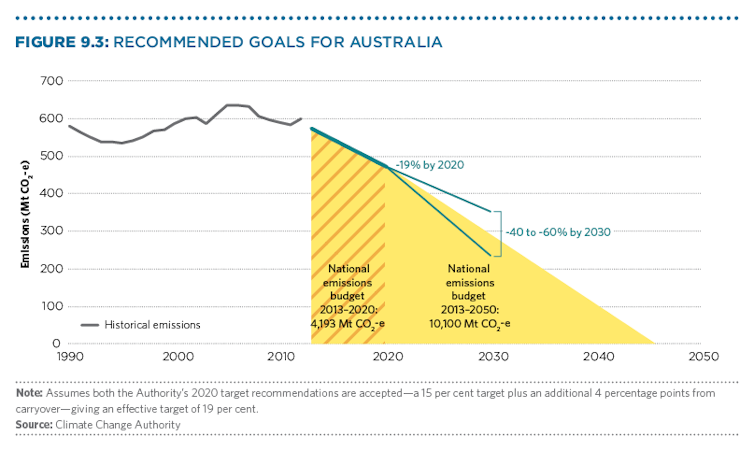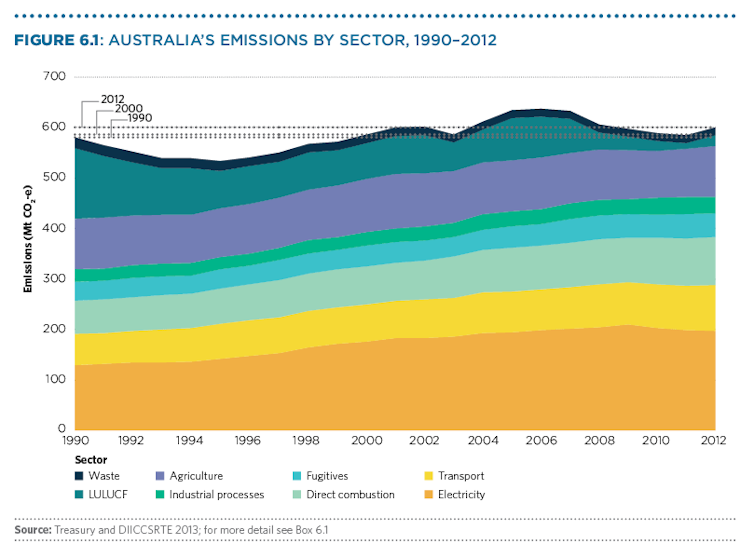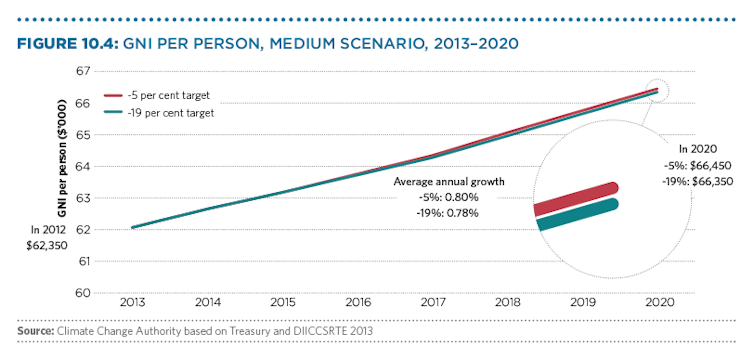The Climate Change Authority’s new report on emission reduction targets makes a compelling argument for Australia to go much further in cutting greenhouse gas emissions.
Instead of the current target of a 5% cut, it recommends emission reductions of 19% by 2020 and 40%-to-60% by 2030 as a responsible path to avoiding the worst impacts of climate change.
The independent Authority arrived at its recommendations using a “budget approach” to emission reductions. It’s an approach that, whatever its immediate impact on the political debate, will reframe thinking about climate policy in Australia.
The budget approach makes it crystal clear that whatever we do over the next few years cannot be divorced from what must be done later.
How does a budget approach work?
Like all nations, Australia has declared its commitment to limiting global warming to no more than 2°C.
Such a commitment imposes a limit on the volume of greenhouse gases that can be emitted over time, because warming is associated with increased concentrations of greenhouse gases in the atmosphere.
It is not so much the emissions that occur in a single year but cumulative emissions that cause the damage.
Globally, total emissions of 1,700 billion tonnes of carbon dioxide equivalent CO2-e over the period 2000-2050 would give the world a 67% chance of keeping warming below 2°C. (This and other figures are referenced in the Authority’s report here.) Given we’re already 0.8°C above pre-industrial levels, the need to move much faster is apparent.
Between 2000 and 2012, the world used up 36% of that budget, leaving 64% for the period 2013 to 2050.
Given the escalating damages from exceeding 2°C, some would opt for a better than two-thirds chance and set a lower budget. For temperatures above 2°C, the Authority refers to an expected doubling to quadrupling of extreme fire danger days in Australia, the destruction of coral reefs and, at the higher range, about 17,000 temperature-related deaths in this country each year.
Doing our fair share
What is Australia’s fair share of a global budget of 1,700 billion tonnes of CO2-e? The Authority opted for an equity principle based on a modified contraction and convergence approach, that is, global convergence to equal per capita emissions by 2050 but allowing for poorer nations to increase their emissions in earlier years so as not to impede economic development.
This fairness principle led the Authority to recommend that Australia adopt a national emissions budget of 10.1 billion tonnes CO2-e for the period 2013 to 2050.
It’s important to stress that this is Australia’s fair contribution to global efforts to limit warming to 2°C. If Australia exceeds this budget then we are either asking the rest of the world, including poor countries with lower per capita emissions, to carry some of our burden or we are effectively abandoning the 2°C commitment and accepting all of the consequences that follow.
Once we adopt a fair, scientifically credible emissions budget, the vital question becomes: When are we going to spend it? That’s the power of the budget approach: what we spend now we do not have available for later.

Put another way, if we behave prudently now, and make strong efforts to reduce our emissions in the next few years, then we will increase our chances of keeping within our budget and give ourselves more options for later. And the current generation will not be offloading the burden onto the next two or three. To use a cricketing analogy, batsmen are always told to complete the first run quickly, because then the option of a second or third run becomes available.
Our 5% target for 2020 is not credible
So when it comes to setting emission reduction targets for 2020 the consequences for what we must do in the following decade, and the decade after that, are inescapable.
For this reason the Authority argues that a 2020 emissions reduction target of 5% below 2000 levels, the current bi-partisan policy of the Coalition and Labor, is not merely inadequate; it is not credible.
As the Authority’s new report puts it, it’s not credible because
a 5% target is inconsistent with Australia’s fair contribution to the long-term global goal to limit warming to below 2 degrees.
The numbers contain a blunt truth. If Australia stays with its 2020 target of 5%, the subsequent decade would require the most stringent program of emission cuts. We would have to halve our emissions in 10 years, and even then we would be left with only 14% of our total budget to cover the remaining 20 years.

The Authority recommends Australia should reduce its emissions by 15% below 2000 levels by 2020 (or 19% taking into account other factors, as I’ll explain shortly), and commit to reducing emissions by 40 to 60% a decade later in 2030. Following that trajectory would, if pursued through to 2050, see the nation keep within its emissions budget.
In the absence of effective policy, by 2020 Australia’s emissions are expected to be 17% higher than they were in 2000, so cutting them to 15% below by 2020 is a considerable task, but one the Authority, after examining the emissions reduction opportunities available, believes is achievable at modest cost.
New targets: 19% by 2020, 40-60% by 2030
The Authority also considered how to treat the 4% “carryover”, that is, the credit to Australia’s account arising from the fact that over 2008-2012 (the years marking the end of the first commitment period of the Kyoto Protocol) our emissions averaged only 104% of 1990 levels instead of our committed amount of 108%.
Coming in under the target had less to do with effective emission reduction policies than the extraordinarily generous deal Australia extracted at the Kyoto conference in 1997 (concessions other leaders called a “disgrace”).
Australia’s “success” in limiting emissions growth has been mostly due to the reduction of land clearing, much of which occurred between 1990 and 1997 as you can see below.

The Authority recommends the 4% carryover be added to the 15% target to give an effective emission reduction target of 19% by 2020.
The recommended 2030 target is as important as the more immediate one. By making a serious commitment to it Australia would finally be setting itself on a credible path to realizing its pledge to play its part in global efforts to limit warming to 2°C.
What would it cost?
Under its legislation, the Authority is required to take account of the economic impacts of its recommendations. It commissioned modelling from the Treasury, which showed that the cost of moving from a 5% to a 19% emission reduction target in 2020 is modest, to say the least.
It’s estimated that adopting the stronger target would reduce the growth rate of Gross National Income (GNI) per Australian from 0.80% to 0.78% each year.
With a 5% target, GNI per person is expected to grow from $62,350 in 2012 to $66,450 in 2020.
With a 19% target, it is expected to grow to $66,350, a shortfall that would be made up within three months.

A $100 drop in GNI per person by 2020 seems like a trifling sacrifice if that’s all it would take for Australia to make a credible contribution to tackling global warming.
The Authority also considered a more far-reaching target of 25% by 2020, which would send an unambiguous signal of commitment and provide more flexibility in the use of our national budget later on.
Some believe such a target is technologically and economically feasible, although if it were adopted, and strong policies implemented, there would be less than six years in which to achieve it, which stretches the boundaries of the politically possible.
Either a 15% or a 25% target (plus the 4% carryover) would see Australia begin to face up to the hard logic imposed on policy by our share of the global emissions budget.
In the past week, Federal Treasurer Joe Hockey has warned that budget and tax reform are urgently needed, saying:
It’s a call to arms to the nation that these things will not be fixed overnight, but we must fix things otherwise we’re going to be guilty of intergenerational theft, effectively.
As the Authority’s new report highlights, budget reform is urgently needed on climate change too. Anything less than the recommended targets imposes an intolerable burden on young Australians, who will be left to make deeper emission cuts in future because we weren’t willing to start now.

